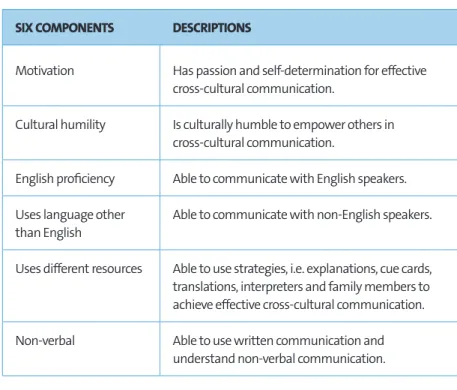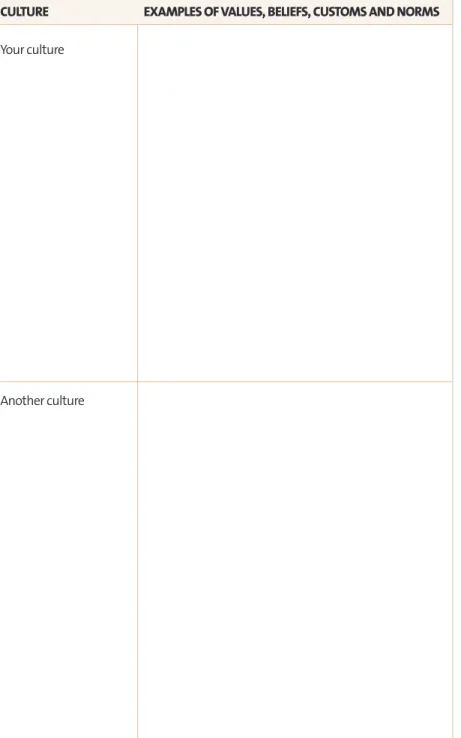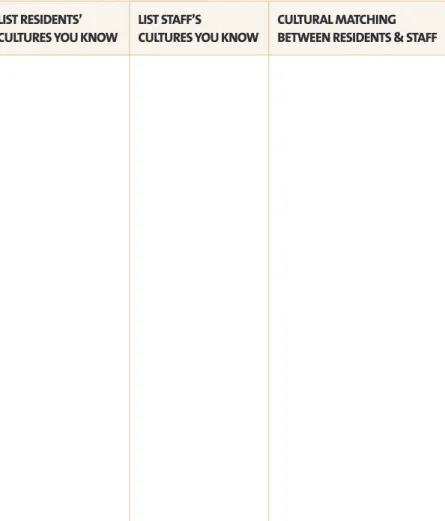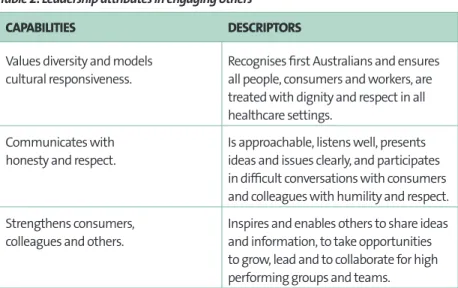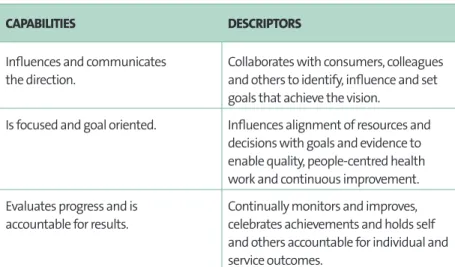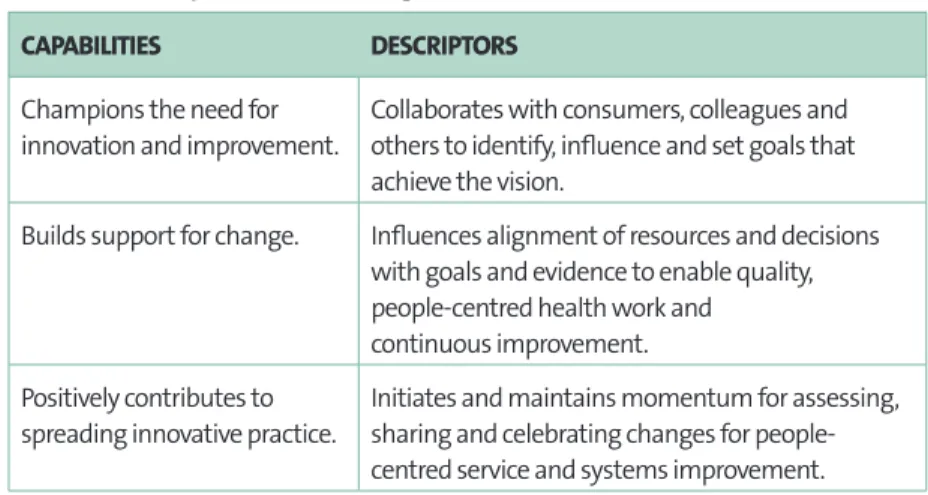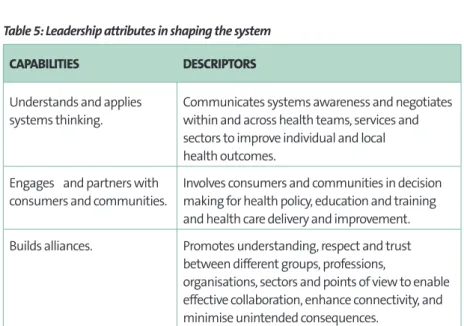Cross-cultural communication Based on feedback from workshops with representatives from: Anglicare SA Inc., Resthaven Inc., Multicultural Communities Council of SA, Alzheimers Australia SA, Australian College of Nursing, Multicultural Aged Care Inc. Cross-Cultural End of Life Care Ms. Helena Kyriazopoulos, Chair of the Multicultural Communities Council of South Australia; Peter Jenkin, Nurse Practitioner Palliative Care, Resthaven Inc.; Dr. Katrina Breaden, Associate Professor of Nursing, Flinders University School of.
LEARNING MODULES IN THE PROGRAM
Cultural and linguistic diversity among residents and staff is significant in aged care homes in Australia. The purpose of this program is to support nursing home staff to provide high quality cross-cultural care to residents and improve them.
INTRODUCTION
However, diversity can also pose a challenge for achieving high-quality care for residents and for staff cohesion. Over the life of the project, the project team worked with residents and staff in four participating retirement homes to implement and evaluate the program.
CROSS-CULTURAL CARE TOOL KIT
Cross-Cultural
Staff will learn principles, knowledge and skills in cross-cultural interaction with residents and team members. Case studies are developed to support staff in applying new knowledge and skills in their practice context.
TEAMWORK TO IMPROVE CROSS-CULTURAL CARE SERVICES
GROUND RULES FOR STAFF INVOLVED IN THE PROGRAM
AN INTRODUCTION TO CROSS-CULTURAL CARE
LEARNING OBJECTIVES
INTRODUCTION TO CROSS-CULTURAL CARE FOR RESIDENTS
Before beginning this learning activity, use the following self-reflection tool to identify your strengths and areas for improvement. For example, you can do a self-reflection with the tool after completing other modules in this training program.
WHAT IS CROSS-CULTURAL CARE?
Why is Mrs. Chang unhappy and what is the right way to address Mrs. Chang. Ahsan apologizes for calling Mrs. Chang by her first name and asks Mrs. Chang how she would like to be addressed.
WHAT IS CROSS-CULTURAL COMMUNICATION?
Staff may encourage Mrs. Talbot to speak English, but also ask her to teach them some French words. While helping her with activities of daily living, staff could practice speaking French words and phrases and encourage Mrs Talbot to speak to them in English.
MEETING RESIDENTS’ RELIGIOUS AND SPIRITUAL CARE NEEDS
Scott could ask Leia's permission to remove the candles immediately and explain the risk of leaving burning candles in her room. Therefore, the electric candles should remain in her room and be used as a substitute for real candles to satisfy Leia's spiritual needs.
INTRODUCTION TO FOSTERING
TEAM COHESION AND COLLABORATION
Miguel, Princess and May felt that Jia's behavior also affected other staff's attitudes towards them and they felt isolated in the workplace. The RNs had also received reports in the past that Mr. Green had referred to several employees by derogatory names.
WORK RELATED ENGLISH
LANGUAGE RESOURCES FOR STAFF
RESOURCES
Department of Health and Aging (2012) National Aging and Aged Care Strategy for People from Culturally and Linguistically Diverse (CALD) Backgrounds. A comparison of verbal communication and psychiatric medication use by Greek and Italian residents with dementia in Australian ethno-specific and mainstream aged care facilities.
CROSS-CULTURAL COMMUNICATION
Discuss challenges and opportunities in achieving cultural competence and cultural humility in staff-residents/their family and friends and staff-staff cross-cultural communication.
LEARNING OBJECTIVES PART 1
LEARNING TO IMPROVE
PRACTICE AND PERFORMANCE CULTURE
CULTURAL AND LINGUISTIC DIVERSITY
CROSS-CULTURAL COMMUNICATION
Use the picture cue to show that they came to help Stefan take a shower. Use written English or pictures to explain Jan's care needs if verbal communication is difficult.
CULTURAL SENSITIVITY
CULTURAL AWARENESS
CULTURAL COMPETENCE
CULTURAL HUMILITY
CASE STUDY 4: CULTURAL INCLUSION IN STAFF COMMUNICATION Recently an incident occurred during lunch in the staff room. In the staff meeting, the care home manager can also encourage staff to discuss the situations where they may need to speak in their first language rather than English, while avoiding situations where it affects other staff.
CULTURAL DIFFERENCES
Dave and Tilly reported to the charge nurse, Elizabeth, that they were tired of this group speaking in a 'foreign' language while in the staff room and felt they were being talked over as this group would at times look on them, say something and then laugh. Please use ü to indicate a good answer and X to indicate a bad answer in the box for each statement.
AN UNFOLDING CASE STUDY - MRS NIKOU COMMUNICATION DIFFICULTIES
AFFECTING THE TRANSITION INTO RESIDENTIAL CARE
AN UNFOLDING CASE STUDY: MRS NIKOU
INTRODUCTION TO MRS NIKOU
Staff should place signs with photos in Ms. Nikou's room and in her bathroom. Based on the information provided, what specific care needs have you identified for Ms. Nikou?
MRS NIKOU IS MAKING PROGRESS TO ADJUST TO HER NEW HOME
What care and services are available and available to meet Ms. Nikou's specific care needs at the facility and what are your suggestions for improving care services. The process of cultural competence in the delivery of health services: a model of care. 1989) Toward a culturally competent system of care.
CROSS-CULTURAL LEADERSHIP
Demonstrate abilities to apply leadership qualities to their own practice in cross-cultural care services. Lead and engage with others to identify and meet residents' care needs in cross-cultural interactions.
PRACTICE AND PERFORMANCE
THE AUSTRALIAN HEALTH LEADERSHIP FRAMEWORK
THE APPLICATION OF THE LEADERSHIP ATTRIBUTES TO CROSS-CULTURAL CARE
LEADS SELF
AGED CARE AND CULTURAL DIVERSITY
Hana suggests that Mary use her right hand to place medication in Mrs. Ali's mouth. RN Mary is willing to learn more from Hana about why the right hand should be used to place the digoxin tablet in Mrs Ali's mouth.
DEVELOPMENT USING CULTURAL ASSETS IN THE WORKFORCE
Bronwyn encourages staff to support Delara to assimilate by supporting and influencing Delara to work effectively with the team. Bronwyn asks a CALD staff member who has successfully adapted to practice in the care home to share her experiences with Delara.
REFLECTION ON LEADERSHIP IN RELATION TO SELF-AWARENESS
Ask Aunt Bindi to share her experiences as an Aboriginal Elder in resident staff cultural activities. Ask Aunt Bindi's daughter, Rosie, to share her experience of caring for her mother before admission to the home at a staff meeting.
ENGAGES OTHERS
She discovers that Mrs. Chen has two main concerns about the food served to her. Care Coordinator Sam could meet with the catering staff to discuss how to meet Ms. Chen's nutritional needs.
ACHIEVES OUTCOMES
Registered nurse Karen noticed that Mrs. Blake was not happy with the loud conversations among the staff. Karen should instruct new staff not to speak any language other than English while working in the facility.
EVIDENCE FOR CROSS-CULTURAL CARE SERVICES
She also noted that staff were very new to the facility and may not have been fully aware of the expected standards in relation to the dining experiences in residents' homes and how this might differ from other workplaces. RN Karen should immediately explain to the new staff in front of the residents that their behavior is unacceptable because they are talking too loudly, making it difficult for the residents to communicate with each other.
RESOURCES FOR CROSS-CULTURAL CARE SERVICES
ASSESSMENT FOR CROSS-CULTURAL CARE SERVICES
Can you find one that can help assess residents' preferences related to their culture? Is the cognitive assessment instrument in the ACFI, the PAS (Psychogeriatric Assessment Scale), suitable for residents with a CALD background?
USEFUL AUDIT TOOL KIT
DRIVES INNOVATION
Nathra's family comes from a Lebanese background and was known around the house for bringing in beautiful food to share with Nathra, such as baklava, kinafa and salads such as pomegranate and tomato. Base Nathra's dietary care plan on food that is already cooked in the facility.
SHAPES SYSTEMS
RN Robyn and Aamod are satisfied with the results of Ms. Chea's treatment and do not report the incident. What the care team could do to address the cultural influence on Mrs. Chea's care needs.
INCIDENT REPORT DATA AS EVIDENCE TO HELP IDENTIFY THE NEED FOR SYSTEMATIC CHANGE
Kim went to registered nurse Evelyn and reported that Mr. Harris had refused to let her administer his insulin. The care coordinator should instruct staff to ensure that Mr Harris does not sit in the dining room or lounge next to a resident with a CALD background.
AN UNFOLDING CASE STUDY IMPROVING TEAM COHESION
IMPROVING TEAM COHESION OverviewOverview
Lin and Kim should discuss how she can apply the principles of intercultural communication in her practice. Michael reports cross-cultural communication problems to the executive director of residential care in his organization.
OUTCOME: CROSS-CULTURAL LEADERSHIP TO SMOOTH THE TRANSITION Discuss the positive impact of cross-cultural leadership on residents and staff
OUTCOME: INTERCULTURAL LEADERSHIP TO REDUCE THE TRANSITION Discuss the positive impact of intercultural leadership on residents and staff.
INTERCULTURAL CONFLICT MANAGEMENT
OPTIONAL
LEARNING MATERIALS
MAINTAINING A GOOD FACE IN INTERCULTURAL CONFLICT
The Department of Social Services offers a Charter of Rights and Responsibilities of Care Recipients - Residential Care with translations in many languages. https://agedcare.health.gov.au/publications-and-articles/guides-advice-and-policies/. charter-of-care-recipients-rights-and-responsibilities-residential-care The Department of Health provides information on all aspects of the aged care system in Australia Aged and aged care accessed online. Understanding and improving communication processes in an increasingly cultural aged care workforce. 2010) Intercultural conflict interaction competence: From theory to practice.
CROSS-CULTURAL DEMENTIA CARE
Explain the impact of culture in dementia care by reflecting on their experiences in cross-cultural interactions with residents and family members. Apply the principles of person-centred dementia care to promote the quality of cross-cultural dementia care.
INTRODUCTION TO DEMENTIA CARE
THE INFLUENCE OF CULTURE ON DEMENTIA CARE
What are some of the things I need to learn in order to meet the care needs of residents with dementia from other cultures.
CONSIDERATIONS IN CROSS-CULTURAL COMMUNICATION WITH RESIDENTS
Jo approaches Mrs. Boczek and tries to help her, but asks her to speak English so she understands what Mrs. Boczek wants. Jo asks another employee who can speak Polish to communicate with Ms. Boczek and help identify her needs.
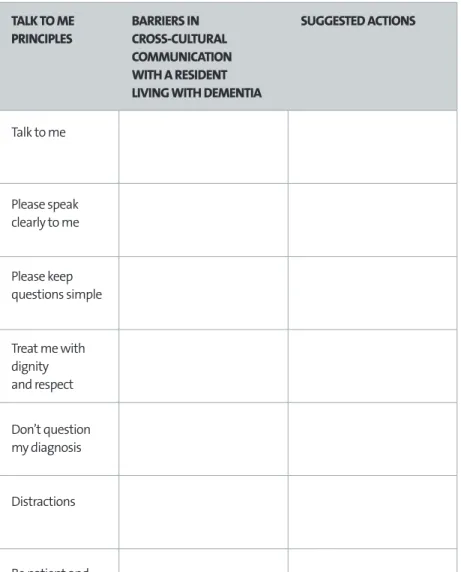
APPLYING A PERSON-CENTRED APPROACH TO CROSS-CULTURAL
113 FRAMEWORK OF VALUABLE PEOPLE TO THINK ABOUT YOUR PERFORMANCE WHEN CARING FOR PEOPLE LIVING WITH INSANITY OF OTHER CULTURES. Share your experiences of poor interactions with a CALD resident living with dementia (Note: be careful not to name people).
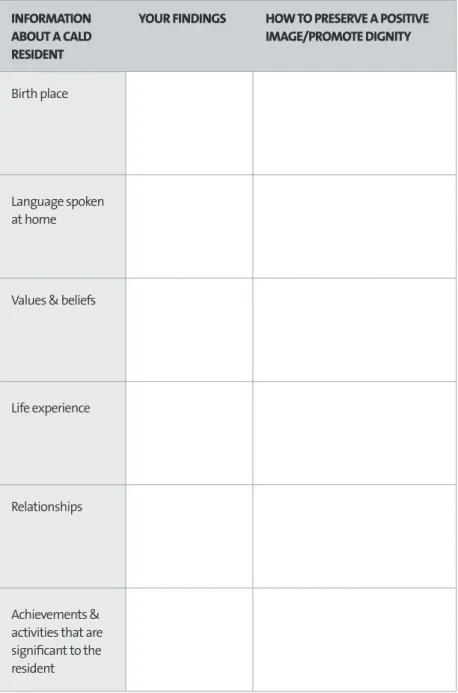
LATE STAGE OF DEMENTIA
A PERSON-CENTRED APPROACH
Mrs. Lan is a Chinese resident in the late stages of dementia who is new to the nursing home. Arrange a meeting with her daughter Jingyin to explore Ms. Lan's history, likes and dislikes, and what she liked to do in the past.
APPLYING A PERSON-CENTRED APPROACH TO THE CARE OF A CALD RESIDENT WHO
The RN should contact Angela's physician for further evaluation to identify potential triggers for the altered behaviors. Work in partnership with Angela's daughter to create a profile of Angela using photos or pictures of important events in her life that she still enjoys.

CULTURALLY AND LINGUISTICALLY APPROPRIATE ASSESSMENT FOR
ACTIVITY 5: GROUP WORK AND DISCUSSION ON IMPROVING CULTURALLY AND LINGUISTIC APPROPRIATE ASSESSMENT FOR RESIDENTS LIVING WITH DEMENTIA. Check the care plan for a resident with a CALD background and find out how culturally and linguistically appropriate cognitive assessment has been used.
AN UNFOLDING CASE STUDY: ANNA
A POLISH RESIDENT WHO HAS DEMENTIA INTRODUCTION TO ANNA
Staff can ask Anna's family to develop clues with both Polish and English words written under pictures to communicate with Anna. Care staff report on Anna's progress and her ability to communicate during team handover, and also by documenting this in her progress notes.
TEAM APPROACHES TO STRENGTHEN CROSS-CULTURAL DEMENTIA CARE
Clinical practice guidelines and principles of care for people with dementia via http://sydney.edu.au/medicine/cdpc/documents/resources/LAVER_Dementia_. Cultural Dementia Assessment Tools - Alzheimer's Australia via https://fightdementia.org.au/about-dementia/resources/culturally-appropriate- dementia-assessment-tools.
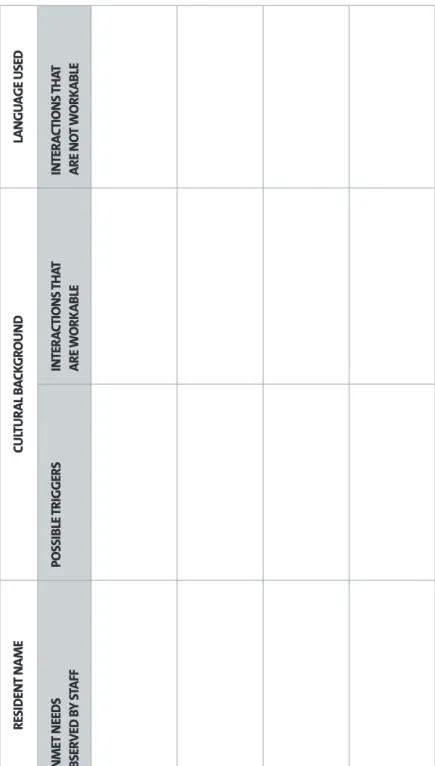
CROSS-CULTURAL END OF LIFE CARE
Explain the impact of different cultures, spiritualities, religions, traditions on end-of-life care for the resident and their families. Apply effective communication principles to interactions with residents and their families to facilitate high-quality intercultural end-of-life care.
PRACTICE AND PERFORMANCE WHAT IS PALLIATIVE CARE?
WHAT IS CROSS-CULTURAL END OF LIFE CARE?
OPTIMAL PAIN MANAGEMENT FOR CALD RESIDENTS WITH ADVANCED DEMENTIA
THE ‘SEE - SAY - DO - WRITE - REVIEW’ MODEL
SELF-REFLECTION
CONSIDERATIONS FOR RESIDENTS WITH DEMENTIA WHEN MANAGING PAIN Dementia adds more complexities for staff to determine whether the resident is in
LOOK': RECOGNIZE AND ASSESS SELF-ASSESSMENT NOTES See if the resident appears to be in pain, especially when they are moving - eg. Write down what you did in the resident's assessment form/clinical record if it is part of your role.

TIPS ON PAIN MANAGEMENT FOR RESIDENTS FROM CALD BACKGROUNDS Culture, religions and language use have a role to play in pain assessment and
In recent days, staff have reported that Mrs Bruno has been unable to eat and drink. Jo should continue her oral care and report Mrs. Bruno's restlessness to David, the RN in charge, after completing the activity.
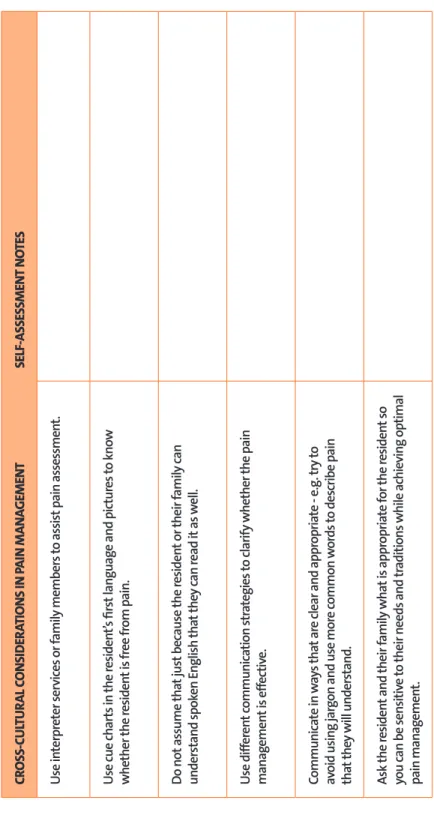
MEETING RESIDENTS’ SPIRITUAL CARE NEEDS IN END OF LIFE CARE
WHAT IS SPIRITUAL CARE?
SPIRITUAL NEEDS IN END OF LIFE CARE
INTERVENTIONS FURTHER EXPLANATION SELF-ASSESSMENT REMARKS Let the resident guide all interventions: Do not impose your own worldview of spirituality on the residents. 151 INTERVENTIONSFURTHER EXPLANATION SELF-ASSESSMENT NOTES Let the resident guide all interventions: Do not impose your own worldview of spirituality on the residents.
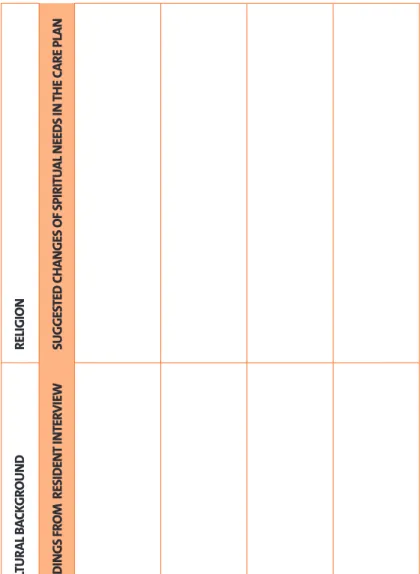
APPLYING A CULTURAL SAFETY CONCEPT TO END OF LIFE CARE FOR
Lin and Marina should report Edna's requirements to management and the charge nurse to discuss end-of-life care options for Edna. Management should contact the Aboriginal Community Controlled Health Organization to discuss resources and how best to meet Edna's end-of-life care needs.
THE INFLUENCE OF RELIGION ON THE END OF LIFE CARE
WHAT IS RELIGION?
RELIGIOUS PRACTICE IN END OF LIFE CARE
THE INFLUENCE OF RELIGIONS AND CULTURES ON ADVANCE CARE PLANNING Religion and culture also influence people's perceptions and actions towards.
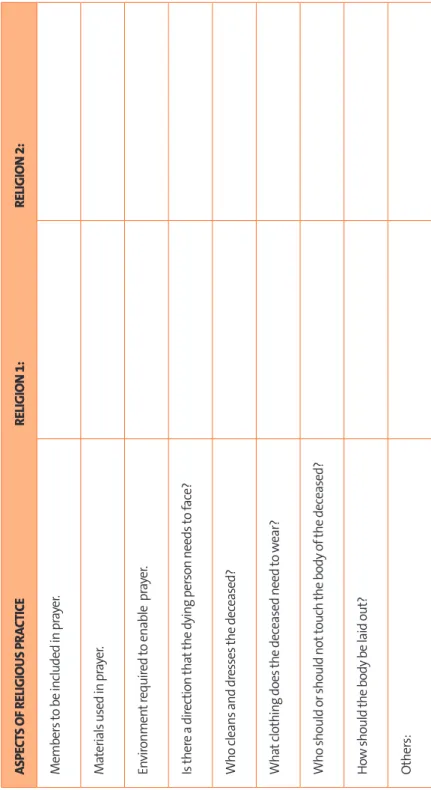
THE INFLUENCE OF RELIGIONS AND CULTURES ON ADVANCE CARE PLANNING Religion and culture also has an impact on people’s perceptions and actions towards
SUPPORTING THE FAMILY WHOSE RELIGION DIFFERS TO STAFF’S It is evident that ‘families who witness a difficult or poorly managed death may
END OF LIFE CARE FOR A RESIDENT FROM ISLAMIC FAITH
In the handover, Jan reported on Asli's reaction to her mother's condition and her request to keep her mother alive. Most staff at the handover said Asli's demands could cause concern for her mother.
AN UNFOLDING CASE ON GRIEF, LOSS AND BEREAVEMENT
INTRODUCTION TO MADAM LI
MADAM LI
SUPPORTING THE FAMILY TO COPE WITH GRIEF, LOSS AND BEREAVEMENT
FenFang reports to the team that Ms. Li's sister has a score of 10 on the loss risk rating. The team assigns Mei-Ling to discuss with Ms. Li's sister a culturally and linguistically appropriate bereavement counseling service that is available in her local area.
PEER SUPPORT AND SELF-CARE
CareSearch of Palliative Care Knowledge Network hjemmeside https://www.caresearch.com.au/Caresearch/Default.aspx. Brisbane South Palliative Care Collaborative & Department of Health (2016) Residential Aged Care Palliative Approach Tool-kit State of Queensland (Queensland Health), Brisbane.
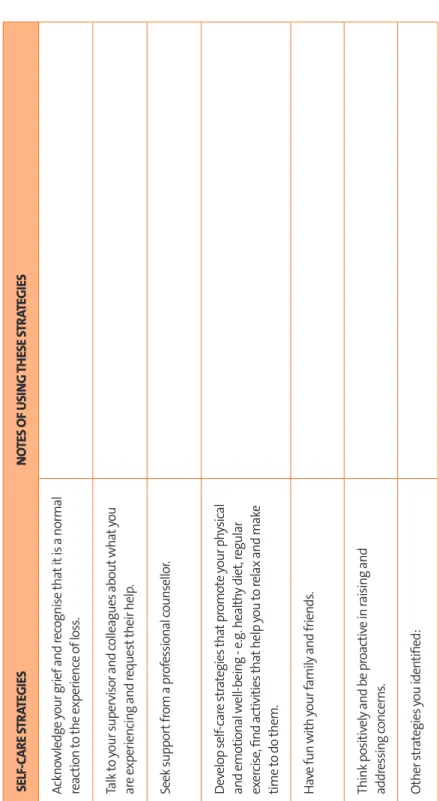
CROSS-CULTURAL CARE TOOL KIT
CROSS-CULTURAL CARE
STAFF SELF-REFLECTION TOOL
CULTURAL HUMILITY AND ITS CHARACTERISTIC SELF-REFLECTION CHARACTERISTICS Effective communication with residents and staff in cross-cultural interactions. CULTURAL HUMILITY AND ITS TRAIT SELF-REFLECTION CHARACTERISTICS Positive attitudes and actions in cross-cultural interactions with residents, families and staff.
CROSS-CULTURAL CARE LEADERS
SELF-REFLECTION TOOL
Driving innovation and improvement I champion the need for innovation and improvement in cross-cultural care and services. 189 Shaping systems I explore, implement and disseminate new care practices regarding cross-cultural care and services.
CROSS-CULTURAL CARE SERVICE AUDIT TOOL
CCCS NEEDS ON ADMISSION AND THROUGH REGULAR CARE PLAN ASSESSMENT SERVICES ARE AVAILABLE TO RESIDENTS TO MEET THEIR NEEDS*. 1 Not identified 2 Partially available 3 Identified N/A Not applicable 1 Not identified 2 Partially accessible 3 Identified N/A Not applicable 1 Not respectful or acceptable 2 Partially acceptable 3 Respectful/acceptable N/A Not applicable 1 Meets standards 2 Continuous improvement 3 Robust evidence use N/A Not applicable .
